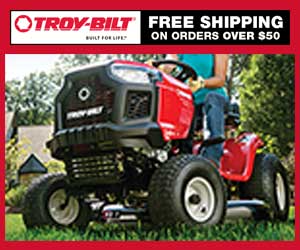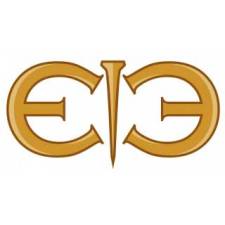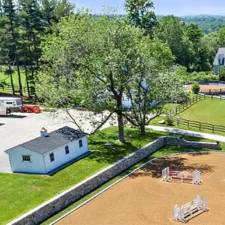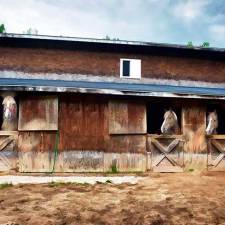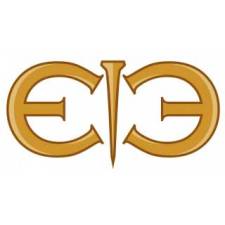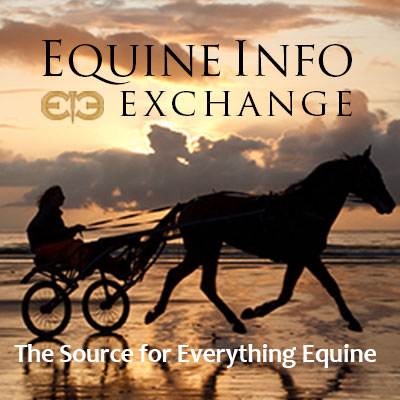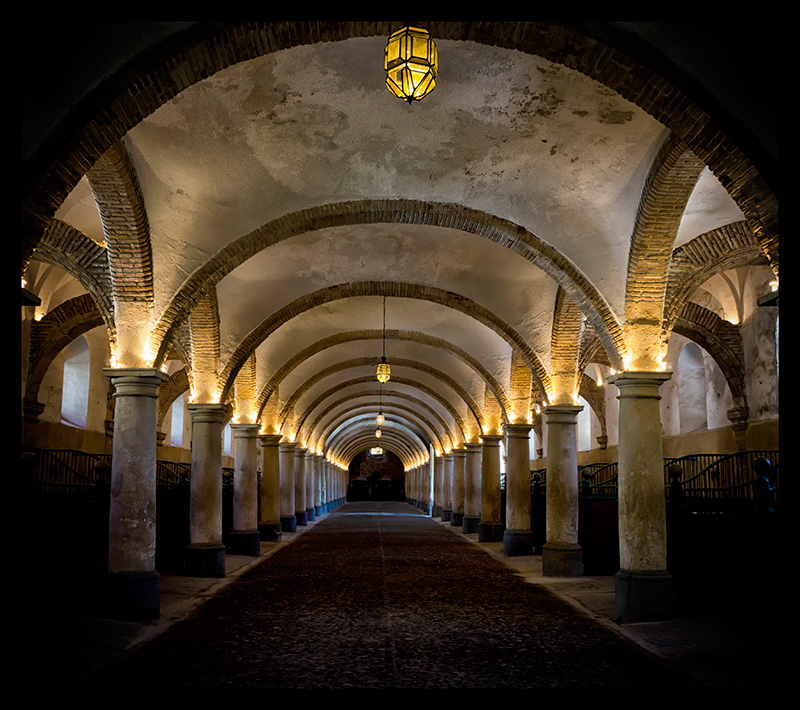
To choose the correct barn or stall for your horse, you need to consider a number of factors, including:
- Size: The barn or stall should be large enough for your horse to move around comfortably.
- Ventilation: The barn or stall should be well-ventilated to prevent the buildup of ammonia and other harmful gases.
- Lighting: The barn or stall should have adequate lighting, both natural and artificial.
- Flooring: The flooring in the barn or stall should be non-slip and easy to clean.
- Drainage: The barn or stall should have good drainage to prevent the accumulation of water.
- Amenities: Some barns offer amenities such as indoor and outdoor arenas, wash stalls, and tack rooms. Consider which amenities are important to you and your horse.
- Location: The barn should be conveniently located for you and your horse.
Once you have considered these factors, you can start to narrow down your choices. Here are some tips for choosing the correct barn or stall for your horse:
- Visit the barn in person: This will give you a chance to see the facilities firsthand and to talk to the barn owner or manager.
- Ask other horse owners for recommendations: Talk to your friends, family, and other horse owners to see which barns they recommend.
- Read online reviews: Online reviews can be a good way to learn more about different barns and to see what other horse owners have to say about them.
- Consider your horse's individual needs: If your horse has any special needs, such as a medical condition or behavioral problem, make sure to choose a barn that can accommodate those needs.
When you are visiting a barn, be sure to pay attention to the following:
- Cleanliness: The barn should be clean and well-maintained.
- Horses: The horses should appear to be healthy and well-cared for.
- Staff: The staff should be knowledgeable and experienced.
- Atmosphere: The barn should have a positive and welcoming atmosphere.
Choosing the correct barn or stall for your horse is an important decision. By taking the time to consider your horse's individual needs and to choose a barn that meets those needs, you can help to ensure that your horse has a happy and healthy home.
Here are some additional tips for choosing and using a barn or stall for your horse:
- Barn:
- Make sure that the barn is properly ventilated to prevent the buildup of ammonia and other harmful gases.
- Clean the barn regularly to remove manure and other debris.
- Provide your horse with fresh water at all times.
By following these tips, you can help to create a safe and healthy environment for your horse.
Featured Listings - Barns & Stalls
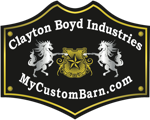 7737 E FM 922, Valley View, Tx 76272
7737 E FM 922, Valley View, Tx 76272
ph: (940) 368-9914
Email: clayton@mycustombarn.com



Horse Custom Barns are CBI’s passion. If you can dream it, CBI can build it! CBI’s barn professionals will work with you one-on-one.
 5075 Lower Valley Road, Atglen, PA 19310
5075 Lower Valley Road, Atglen, PA 19310
ph: 888-447-4337 | 888-44SHEDS
Email: info@HorizonStructures.com



"Your Custom Barn Builders" Our specialty is prebuilt and modular horse barns. Every Horizon Structures horse barn is built-to-order with a wide range of customization options. You get the Amish-built barn you've always dreamed of at an affordable price.
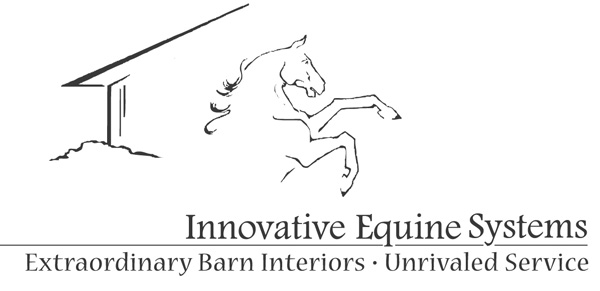 2559 Precision Drive, Suite 4, Minden, NV 89423
2559 Precision Drive, Suite 4, Minden, NV 89423
ph: (800) 888-9921
Email: info@equinesystems.com


We offer a full equestrian product line, including barns and arenas, stalls, exterior doors and shutters, rubber flooring and barn accessories.
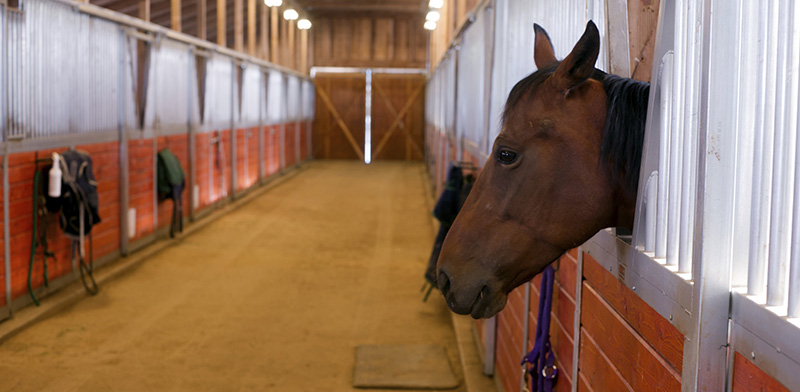
Barns & Stalls
- A&B Barns
- American Stalls
- Amish Barn Company
- Amish Customs
- B&D Builders
- Barn Pros
- Brad's Barns & Gazebos
- Carport Central
- Carri-Lite Corrals
- Cashmans
- Castlebrook Barns
- Cherokee Structures
- Chinook Stalls
- Circle B Barn Co.
- Classic Equine Equipment
-
Clayton Boyd Industries

7737 E FM 922, Valley View, Tx 76272
ph: (940) 368-9914
Email: clayton@mycustombarn.com



Horse Custom Barns are CBI’s passion. If you can dream it, CBI can build it! CBI’s barn professionals will work with you one-on-one.
- ClearSpan
- Coastal Steel Structures
- Country Carpenters
- Country Mfg.
- Deer Creek Stables
-
DIY Pole Barns

9232 Hogpath Road, Arcanum, Ohio 45304
ph: (937) 547-9100
Email: sales@diypolebarns.com


DIY Pole Barns is based at the epicenter of the pole barn industry – rural Western Ohio.
- Equestrian Fencing
- Equine Barn Company
- FBi Buildings
- FCP Barns & Buildings
-
Graber Buildings

491 Gap-Newport Pike, Highway 41, Atglen, PA 19310
ph: (610) 593-3500

- Hi-Hog Ranch & Farm Equipment
- Hill View Mini Barns
- Hilltop Structures
-
Horizon Structures - Quality Horse Barns

5075 Lower Valley Road, Atglen, PA 19310
ph: 888-447-4337 | 888-44SHEDS
Email: info@HorizonStructures.com



"Your Custom Barn Builders" Our specialty is prebuilt and modular horse barns. Every Horizon Structures horse barn is built-to-order with a wide range of customization options. You get the Amish-built barn you've always dreamed of at an affordable price.
- Horse Stalls
- Horse Stalls USA
-
Innovative Equine Systems

2559 Precision Drive, Suite 4, Minden, NV 89423
ph: (800) 888-9921
Email: info@equinesystems.com


We offer a full equestrian product line, including barns and arenas, stalls, exterior doors and shutters, rubber flooring and barn accessories.
- J&N Structures
- Jamaica Tent Company
- Keystone Barns
- King Contruction Company, LLC
- Lucas Equine Equipment
- MD Barnmaster
- Metal Horse Barns at Viking Steel Structures
- Morton Buildings
- National Barn Company
- Neubauer Manufacturing
- Noble Panels & Gates
- NorCal Structures
- Old Town Barns
- Precise Buildings
- Quarry View Building Group
- RAMM Horse Fencing & Stalls
- Rockin J Equine
- Salem Structures
- Sand Creek Post & Beam
- Saratoga Stalls
- Showtime Stall Rentals
- Stateline Builders
- Stoltzfus Builders
- Sunset Barns
- System Fencing
- The Barn Factory
- Titan Steel Structures
- Tri-County Barns
- Trilogy Barn & Stable Company
- Tritron Barn Systems
- Walter Buildings
- Waterloo Structures
- WeCover Structures
- Windy Hill Sheds
- Woodys Barns
Barns & Stalls - Architects
- Agrarian
- Blackburn
- Bucks County TimberCraft, Inc.
- CMW Equine Architects
- DC Builders
- Equine Facility Design
- Equine Planning Solutions
- General Assembly, 98 4th Street Suite 323, Brooklyn NY 11231
- GH2 Gralla Equine Architects
- Harrison Banks
- Hayward & Company
- J Martinolich Architect
- John Sava Architecture
- KWA Architects & Planning Consultants
- Ladd Hudson Architects
- Old Town Barns
- Pegasus Design Group
- Shope Reno Wharton
- Smiros & Smiros
- Wilmes & Associates Architects
- Wilson Door and Construction
Barns & Stalls - Dust Control
Barns & Stalls - Engraved Name Plates
Barns & Stalls - Fly Control
Barns & Stalls - Footing
Barns & Stalls - Rubber Flooring
-
Innovative Equine Systems

2559 Precision Drive, Suite 4, Minden, NV 89423
ph: (800) 888-9921
Email: info@equinesystems.com


We offer a full equestrian product line, including barns and arenas, stalls, exterior doors and shutters, rubber flooring and barn accessories.
Barns & Stalls - Security
Barns & Stalls - Solar Energy
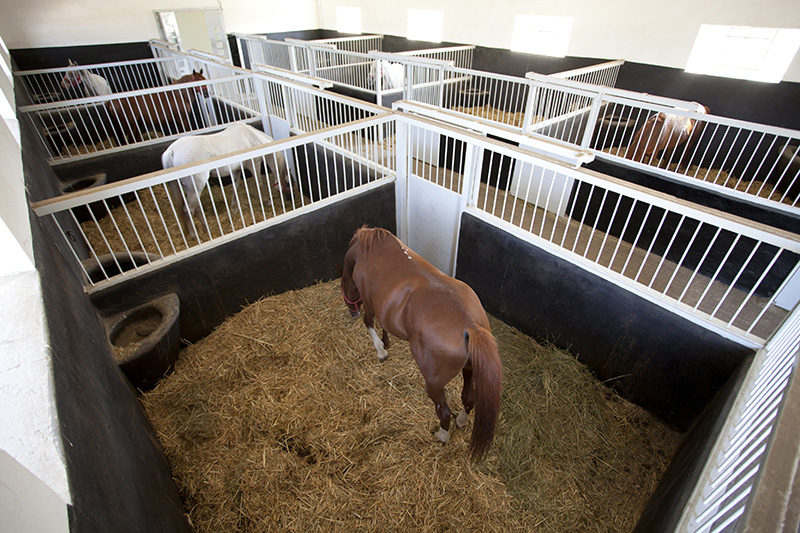
Summer Safety: Barn Fans & Automatic Horse Waterers
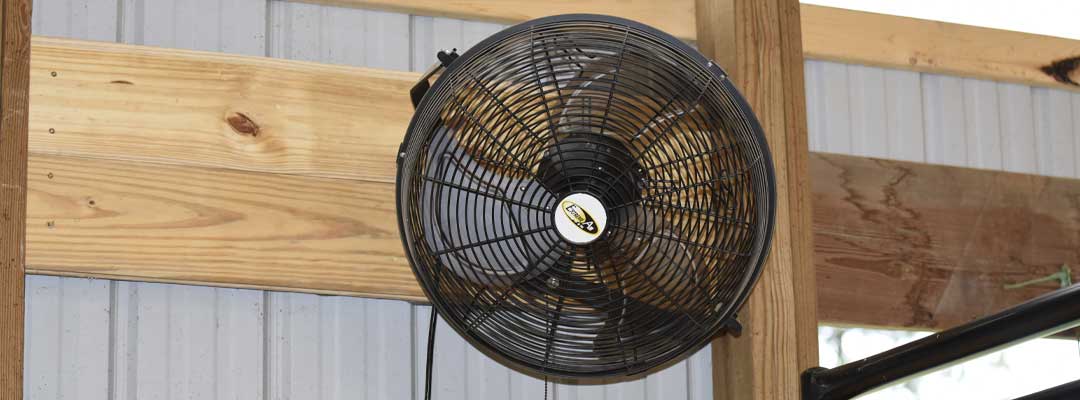
Quality horse stall fans and fresh water aids in horse comfort and heatstroke prevention.
As summer temperatures continue to rise, make sure you’re taking precautions to avoid heatstroke in horses and keep horses comfortable overall. Two important actions to take include installing barn fans and providing horses access to ample fresh, clean water -- always.
Preston Hickman, DVM, Wichita Equine and Sports Medicine, detailed heatstroke in horses and commons signs horse owners need to know:
“Heatstroke resembles a horse tying up and or in shock but can resemble a horse with exhaustion when they collapse. An exhausted horse might be distressed and anxious. He might have a high heart and respiratory rate that does not decrease with rest, and his skin might feel hot and dry.
Some horses become stiff and experience pain due to muscle cell damage, which can be detected by observing red or brown urine (hemoglobin and/or myoglobin uria). Horses affected this badly might go down or develop other, often life-threatening conditions such as laminitis, kidney failure or diarrhea.”
Signs of heat stroke in horses include:
- Temperature as high as 105 to 107 F
- Rapid breathing, rapid pulse
- Stumbling, weakness, depression
- Refusal to eat or work
- Dry skin and dehydration
- In severe cases, a horse may collapse or go into convulsions or a coma
BARN FANS
There are many reasons to keep your horse’s temperature under control ranging from heat stroke prevention mentioned above, as well as performance enhancement, fly control and more. When selecting your next barn fan, here are a few things to consider.
Be safe! Choose horse stall fans with an enclosed motor. This will keep dust and debris out and the fan operating as expected. More so, an enclosed motor barn fan helps prevent barn fire risk for your animals. While box fans are commonly found in horse barns, they present greater fire risk as dust and hay can more easily reach the motor, which can potentially cause a fire.
Keep barn fans clean to keep fresh air circulating in your barn. Choose a waterproof model for easy cleaning.
Keep all barn fans pointing in the same direction, with the natural flow of air to maximize circulation.
With a powder-coated mounting bracket and aluminum blades, this premium 18" indoor or outdoor fan stands up in humidity, rain and fog and ranks high among agricultural fans with its increased longevity and corrosion resistance.
With a fully enclosed motor, this direct-drive waterproof outdoor fan is maintenance-free and can easily be sprayed down to remove dirt and dust build-up to help ensure both safety and function.
FRESH WATER
The most important nutrient horses receive, and especially during warmer weather, is water. Always make sure horses have access to ample amounts of fresh water. According to the American Association of Equine Practitioners, “An idle 1,100-pound horse in a cool environment will drink 6 to 10 gallons of water per day.
That amount may increase to 15 gallons per day in a hot environment. Work horses require 10 to 18 gallons of water per day on average but could require much more in hot weather.”
The amount of fresh water available to your horse, and the source from which it originates, is critical. During warmer weather especially, water sources such as ponds and troughs can quickly generate dangerous algae. While most algae are harmless, certain types can increase horse colic risk, such as blue-green algae, also known as cyanobacteria.
Automatic horse waterers can conveniently offer horses ample fresh and safe water when it’s needed the most
Visit Valley Vet to learn more.
All photographs and images courtesy of Valley Vet.
This article originally appeared on Valley Vet and is published here with permission. Valley Vet Supply was founded in 1985 by veterinarians for people just like you - people who want the very best for their four-legged friends and livestock.
There are more informative articles in our section on Health & Education.
Are you interested in promoting your business or sharing content on EIE? Contact us at info@equineinfoexchange.com
Arena Footing Basics 101
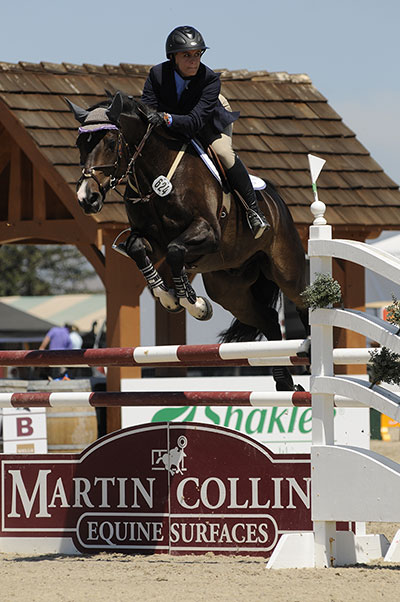
by Martin Collins
Equestrians will agree, when it comes to arena riding, a well-appointed ring is a joy to work (and play!) in. The footing you choose for your enclosure will depend on a variety of factors and will be the most important component of a well-designed and properly constructed riding area.
In this article, Glynnie Walford of Martin Collins© Equine Surfaces provides the information you need to create a first-rate surface for all of your equine endeavors.
Building Your Arena’s Foundation
Next to the footing, the base is the most important part of your arena, and often something that gets overlooked during construction. Here are a few things to consider before starting any new construction.
Cut and Fill
Cut and Fill is the process of cutting into a bank and re-laying the material lower down the bank to create a “level formation” for your outdoor equine arena. The banks/ slopes must be created correctly to support the new formation.
The more level the site, the less cost will be involved in the initial stages of construction.
Build at the Right Time of Year
The best time to build a new arena is during a dry period, preferably in the late spring/summer early fall. This will make for less disruption and a cleaner site with which to work. It will also be easier for trucks delivering aggregate etc. to drive onto the property with good ground conditions.
Various types of sub soil need to be taken into consideration: Clay in particular needs to be carefully managed, especially during earthworks such as “cut and fill,” so “clay heave” does not occur. (This is most likely to occur when the clay is wet and under pressure, which causes it to “bubble up.”
This can move the stone layer and membranes, leading to contamination of the surface and poor drainage. Should this occur, remedial works will be necessary.)
A sheltered spot is preferable, however, watch for trees and construct away from roots. Be mindful of leaf contamination in the fall as these will need to be removed because if left, they will rot and contaminate the footing.
If you are forced to construct on an exposed site, be wary of the footing you choose so as not to lose it during windy weather!
Keep away from utilities and obstructions that may be costly to move.
If the arena is situated any distance from the barn, ensure that you plan for an approach ‘track’ so that no debris is taken into the new footing by the hooves of horses and also maintenance equipment. This can be of a similar surface to the arena or an aggregate.
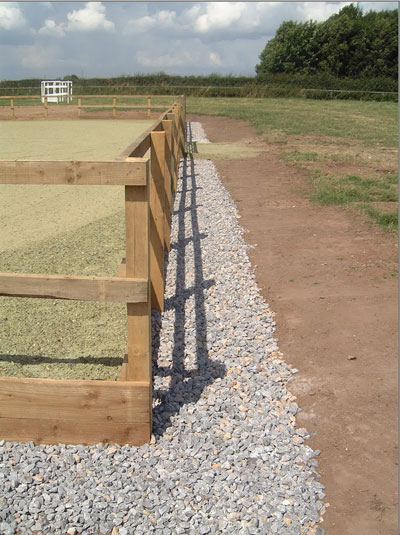
Pay Attention to Drainage
Internal drains should be spaced every 30 feet linking into a perimeter and then to outfalls to take surface water away. This is generic and will alter dependent upon the type of sub soil under the construction location.
If the ground is heavy clay, additional cross drains may be required and the diameter of the exterior drains may have to be increased.
It is important that the drain runs have a consistent fall. Ensure drainage trenches are backfilled with clean drainage gravel with no fines or dust content as this can block the trenches over a period of time.
The tops of all the trenches and overall arena should be covered with a fine grade (e.g. 4 oz.) non-woven geotextile membrane. This acts as a separator between the earth and clean stone layer. This will allow the water to pass in to the drains, but will prevent silt/ sediment from doing the same.
It is important to include drainage trenches on the outside of the arena. These external drains will stop the “run off” from adjacent paddocks – so this is especially important if an arena has been cut into the slope. They are also important because the outside track typically has the heaviest “foot fall.”
Use Quality Stone for your Base
The types of stone used do vary from state to state but as a generic for those states that experience low temperatures in the winter: For the base layer (stone drainage layer), it is VITAL that clean, hard, angular stone is used. Hard: means the stones are frost resistant, i.e. will not break down after successive winters or fracture due to the weight of maintenance machinery.
The quarry can provide ‘technical data sheets’ if in any doubt. An indicator test: Take two stones and bang them together, they should not dust, crack or break. If they do, they are not frost resistant.
Angular stones must inter-link together, so they need to be of similar size, typically 1 ¾” to 2 ¾”. (If the stone is rounded it will never “knit” together, so the surface will never be correctly compacted if the base layer moves.)
Clean: means the stone has been washed so stone dust/ fine soil is not washed straight in to your drains, causing reduced flow of surplus water. The stone layer should be 4” compacted depth when laid (dependent upon type of sub-soil), ideally the stone layer should extend 20” beyond the fence/ kick boards so the perimeter drain is laid outside the school.
Be cautious if your contractor does not specify the grade/ quantity or depth of the materials being laid. Clearly if less stone is used, it will be cheaper and some contractors will reduce the specification and price in order to win the work.
Choosing the Right Surface
Well-kept, ‘good going’ turf is the ideal surface for training and equestrian competitions; it is the traditional footing for all equestrian sports. However, in situations where turf cannot be sustained, all-weather surfaces for horses allow them to train and compete in different situations and weather conditions.
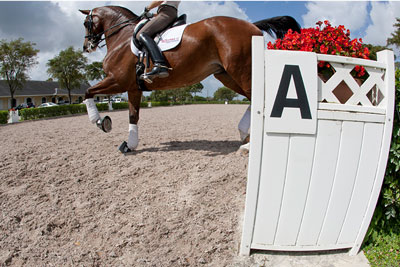
There are six main types of surfaces for horses available in the U.S. – fibers, sand/ mix, dirt, wood products, rubber, and coated (often referred to as all-weather).
These days PVC and rubber are less popular choices as they tend to “ride deep” in dry periods and disposal legislation is becoming restrictive; so structural fibers are becoming the norm.
* Coated Surfaces There are several types of coated equestrian surfaces that do not require irrigating however, ensure that you fully investigate the product you are interested in and take the opportunity of speaking to existing clients. This will give you the benefit of their knowledge of both riding and maintaining their rings. Check on the longevity of the coating and the rejuvenation process.
* Dry, Sand-Based Surfaces Dry, sand-based surfaces refer to equestrian surfaces made up of sand, mixed or topped with another material such as rubber or synthetic fibers. This addition of fibers to sand is becoming the most commonly used equestrian surface of the 21st century.
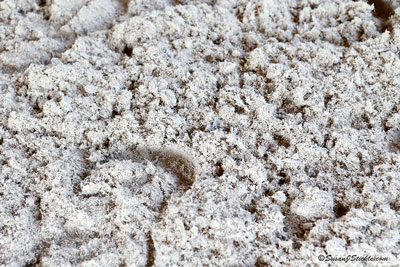
Upgrading Your Arena Surface
Extreme weather conditions inevitably put added pressure on your arena surface. Common problems are that surfaces become either too firm or too deep, and – in the case of sand-based surfaces – dry and dusty. If your surface is suffering, don’t automatically assume that it’s a case of facing the expense of entire replacement.
A complete overhaul is not always necessary (and certainly not always within an individual’s budget). Consider, instead surface enhancement, or refurbishment. Replacing the whole surface is, of course always an option. However, it is advisable to verify the condition of the underlying base. If the base is in need of remedial work this should be done before any replacement of surface, otherwise you will only be ‘throwing good money after bad’!
Care and Maintenance of Your Surface
The amount and type of arena grooming often depends on what type of surface you have. Some of the ‘dry’ surfaces require more water or grooming than others.
* Coated Surfaces
Coated riding surfaces are predominantly dust free (providing the manufacturer’s maintenance procedure is adhered to) and have a very good climactic tolerance and do not require an irrigation system. It is worth noting that Martin Collins wax coated synthetic horse riding surfaces are NOT coated with oils or petroleum jellies for two important reasons:
Some oils can wash through the surface and render the underlying base impervious. They are susceptible to melting in the warmer weather causing inconsistent ‘going’.
Neither oils nor petroleum jellies have the same lifespan as a wax-coated surface and will therefore require re-coating much sooner.
* Non-Coated
Non-coated riding surfaces require more maintenance than those with a wax coating. For optimum performance, an irrigation system is essential. Once a surface has dried out it can ride “deep” and can quickly become un-level. However, this can be rectified with specialized machinery.

Care advice for all synthetic riding surfaces
Martin Collins surfaces are sold to provide an average COMPACTED depth of approximately 4” when laid. Some others are sold UNCOMPACTED so, when laid, the depth can be reduced by 2″ (50mm). The following advice applies to all surfaces.
It is important that your new surface is kept both level and evenly compacted. If any hollows, dips or tracking appear, these should be corrected by hand raking prior to grooming the surface.
As previously mentioned, it is advisable to provide a clean approach to the arena to prevent both horses and maintenance equipment from bringing debris onto the footing and contaminating it.
When jumping fences should be moved frequently, and takeoff and landing pads hand raked before the stands are put away.

Making Your Riding Surface Last
The life span of a correctly installed and high performance riding surface will be determined by a range of factors. To protect your investment:
• Follow the manufacturer’s recommended maintenance guidelines.
• Lift all debris, horse droppings, leaf fall, etc.
• Carry out regular depth checks; these will immediately flag “dangerous” inconsistencies in overall depth i.e. 2” – 6”.
• Construct a track to the arena to keep horses’ feet and maintenance equipment clean when entering the arena.
The Size of the School
If you have a very small school, you may find the surface wears a little more quickly, as the horses are working “on the turn.” There is more pressure on the footing on turns, so lay additional depth for safety. The footing provider should assist and recommend the depth in such instances.

In Closing…
The above information is intended as a guide for those planning/ constructing a new riding surface or upgrading a pre-existing one. Remember, a thoughtful investment of time and finances now will ensure less time spent worrying about your arena – and more time enjoying it – for years to come.
North America’s premier equestrian footing experts, Martin Collins USA, have provided this important guide on arena material selection and construction. To learn more about Martin Collins surfaces, or to request a no-obligation quote, visit www.martincollinsusa.com.
You can also find Martin Collins Equine Services in the Footing section of our Barns & Stalls page.
Is it Time to Walk Your One True Love Down the Center Aisle?
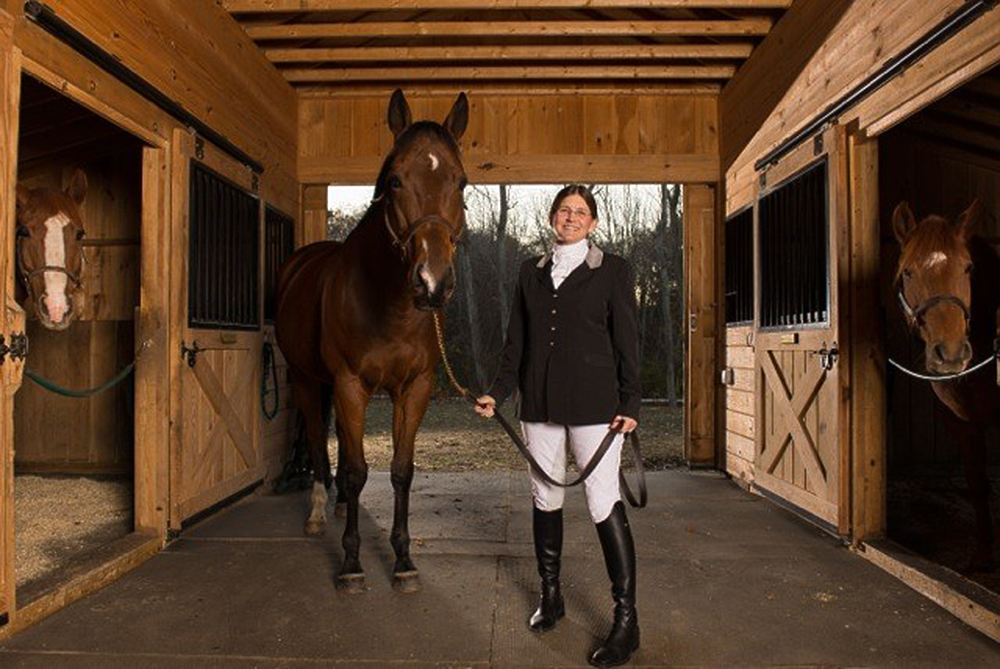
By Nikki Alvin-Smith
When I arrived in America from Great Britain eons ago, I was soon engrossed in everything horse. In fact, it only took me a few months to purchase my first USA horse and put him in livery. My first and only boarding barn experience was at Caumsett State Park Stables, Lloyds Harbor, NY, at the previous estate of Marshall Field, the American entrepreneur and founder of Marshall Field of the Chicago-based department stores.
While the majority of horses were stabled in the new forty stall metal structure with two long aisles with ten stalls set each side of a center space, the original brick built polo barn was home to a couple of Grand Prix showjumpers, and also the location for the only bathroom available, so trips to and from and through the grand building were a necessity.
These trips would have been much more enjoyable without having to negotiate the fierce Dobermans, named Angel and Lucifer, who the leaseholders of the property kept on the farm (at some point Lucifer attacked our poodle resulting in an expensive veterinary visit so that dog was aptly named).
Despite the dogs unwanted accompaniment of my visits, as I walked through these beautiful stables the center aisle design was obviously a superb idea.
The center aisle design was especially appreciated during our first American winter, when the weather surprised us with its tenacity and three feet of snow. Blissfully unaware of how difficult negotiating the drive to the barn would be, we knew once there we would find safe harbor from the weather in the center aisle barn to tack up before we headed to the indoor to ride.
En route to the barn we encountered the scary appearance of a huge bright yellow behemoth, a snowplow, which tore through the country road with little regard for where we were going to place our car to avoid a head on collision. It was quite a surprise to us, as England had no snowplows (even now I believe the country only has a handful).
So my introduction and appreciation for a center aisle barn was complete. The usefulness of the inside space for farrier work, clipping, grooming was apparent. I had never used crossties before and regarded them with some suspicion. Thankfully my horse McCloud knew all about them, and they were very useful.
In England my experience had been with shedrow and L-shaped horse yards. This new American center aisle barn was an interesting discovery. When we built our first barn on our first farm the following winter it was shedrow, mainly because this was the easiest and cheapest design that we could afford with our new mortgage.
Later we added more shedrows and L-shapes. Our final barn build on that farm was a center aisle. All our barns were hand built by just hubbie and myself and while we started with hammer and nails, by the final barn we had super tools and I could wield a nail gun and lay shingle.
Yes, we had succumbed to the center aisle design. Joy of joys! No more schlepping about in the snow and wind and rain. It was time to walk my one true love down the center aisle. I mean my horse of course. Did you think I meant hubbie. Don’t tell him.
There are lots of points to consider when you opt for a center aisle barn design. Here are a few tips to help you make a good marriage with your needs and your wants in a new barn build.
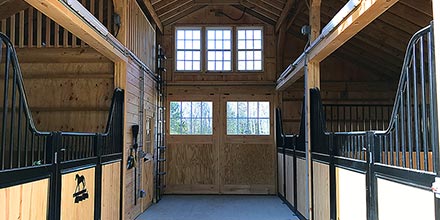
Width Matters
The width of the aisle affects safety. If you know you are going to have boarders with tack trunks, blanket rails etc. and general clutter then you’ll need more than the minimum of 10 feet. There should be room for two horses to safely pass each other especially in a busy barn environment.
Cross ties can be placed in the center of the aisle but if it is a busy space having at least one grooming stall on the side of the aisle is a great idea for handler and horse safety.
Widths of 12, 14 or 16 feet are common. Obviously with the larger widths a grooming stall is a necessity.
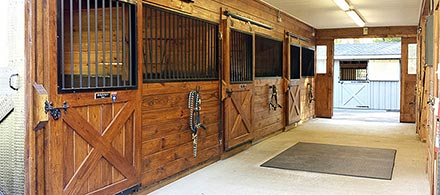
Door Safety
For safety all aisle stall doors should be sliding doors. Opening doors into the aisle is dangerous for both horse and handler. One good knock on the horse’s hip can cause permanent lameness. Always be certain the doors are a minimum of four foot wide and sliding if possible.
For added ventilation having Dutch doors that face the outside of the barn can be a great idea. Be cognizant of your anticipated horse’s size and ensure the bottom door is high enough to prevent the horse attempting to jump out (install a V-grill if necessary), and that all edges are protected by chewguards as most horses will chew when they are bored. Dutch doors also alleviate boredom for your equine partners as they can look about and enjoy the sights.
An overhang is also a great idea to keep poor weather out of the stall, and offer shelter from the sun.
The front wall and sliding doors should be grilled if you expect to have horses stabled and don’t want to run the risk of them attacking passer-by or other horses being led through the aisle, and especially if you have young or high strung horses that will rear and become excited when stalled.
Options such as feed grills are a great idea, as it saves going into the stall each day to feed. When planning your barn always compare apples to apples. These extra features can be expensive to add later, and a complete quote that encompasses all your needs and some of your wants and stays on budget but delivers just what you expected with a good warranty backing up the build is sincerely important.
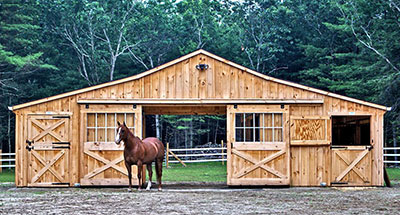
Barn Placement and Height
When placing the barn avoid having the aisle face the prevailing wind, as the ensuing wind tunnel will prove a challenge during winter months. The end doors can be solid for security or have tempered glass in the top portion to allow light into the building.
Height of the building should also be considered. Regardless of whether you opt for a stick built barn or a convenient modular build you want the barn to fit into the landscape. For example a high profile modular barn will offer the option of installing a loft space for storage above the stalls.
A low profile barn may better match the height of your existing dwelling on the property and is an extremely cost efficient method to enjoy the benefits of a center aisle barn.
Always be certain that the builder is cognizant of the snow load factor for your area and that the barn is properly engineered to handle what Mother Nature may bring to the equation. This is especially important if you live in an area where agricultural buildings are not subject to permits and no-one is checking the structure for competency.
Be aware that a low profile barn may have a roof pitch of 4/12 while a high profile build may be 8/12 pitch or more. The roofing material is as important as the pitch, because ice and snow will slide off a metal roof better than off a shingle roof. Of course, having a pile of snow just outside your building can pose snowmelt issues, so be certain you have installed drainage to take the melt away.
It always pays to consult a professional on these topics, and a good company will be happy to take the time to explain your options and to help you stay on budget with a properly engineered truss system.
Also in regard to roofing consider adding an insulation layer beneath the roof to help defray the heat and cold factor in the barn. An insulating layer will also prevent condensation dripping from a tin roof.
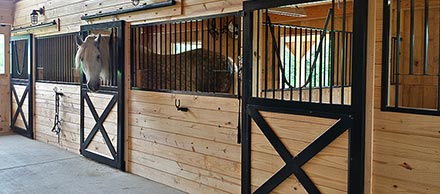
Light & Airy
Stall windows should be designed for ease of cleaning and have safety grills to protect the horses when stalled. Ideally the windows will have a screen and can be opened during hot summer months to enable a breeze to cool the barn.
Cupolas are perfect for adding an electric fan to draw hot air through the barn during summer months and to keep air moving. If you are installing stall fans be certain to use only commercial grade fans and keep them dust free to help prevent a fire hazard.
In conclusion the center aisle barn is a tremendously useful design, especially for areas where Mother Nature can be inclement. The cozy feel as you step out of the wind and into the barn and close that door behind you, greeted with the scents of everything horse and the contented munching of your equine beasties is priceless.
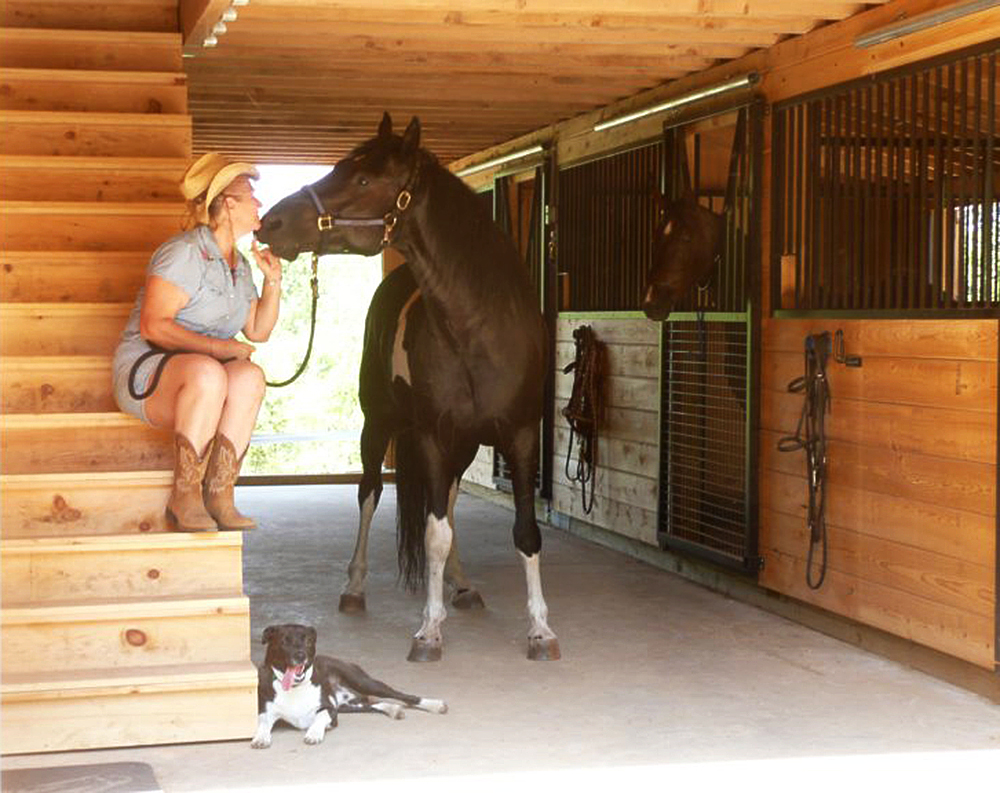
Yes. It’s true. While you may start out with one horse you’ll have more than one horse of course, once that barn is build. Don’t tell hubbie! Enjoy walking your multiple true loves down that center aisle everyday.
This article is brought to you courtesy of Horizon Structures Inc., Atglen PA – Modular horse barn and indoor riding arena specialists. Please visit https://www.HorizonStructures.com to learn more.
About Horizon Structures: One horse or twenty, there's one thing all horse owners have in common...the need to provide safe and secure shelter for their equine partners. At Horizon Structures, we combine expert craftsmanship, top-of-the-line materials and smart "horse-friendly" design to create a full line of sheds and barns that any horse owner can feel confident is the right choice for their horses' stabling needs.
All wood. Amish Made. Most of our buildings are shipped 100% pre-built and ready for same-day use. Larger barns are a modular construction and can be ready for your horses in less than a week. All our barn packages include everything you need.
Horizon Structures also sells indoor riding arenas, chicken coops, dog kennels, 1 and 2 car garages, storage sheds and outdoor living structures.
Headquartered in South-Central Pennsylvania, Horizon Structures, LLC is owned by Dave Zook. Dave was raised in the Amish tradition and grew up working in the family-owned shed business. He started Horizon Structures in 2001 in response to an ever-increasing customer demand for high quality, affordable horse barns.
For additional information about the company or their product line, please visit their website at www.horizonstructures.com
About Nikki Alvin-Smith: International and national published freelance writer and photographer in such world renowned publications such as The Chronicle of the Horse, Horse and Hound, Dressage and CT, The Horseman’s Yankee Pedlar, The Equine Journal, Spur, Hoofprint, Horsin’ Around, Horses All, Field & Stream, Horse Bits, Pony Quarterly, Catskill Horse to name a few.
Ghostwriting, blog services, PR/Marketing copy either direct with manufacturer or for agencies, copy editing and editor services also available. Nikki has produced catalog copy, corporate brochures and advertising copy for international corporations and PR/Marketing for celebrities.
As a Brit who has called the America home for the past 34 years, Nikki brings a unique perspective to the equestrian world. Nikki is also an accomplished Grand Prix dressage trainer/competitor, competing at international Grand Prix level to scores over 72% and is a highly sought clinician offering clinics worldwide.
She has been a horse breeder/importer of warmblood and Baroque breeds for more than 25 years. Together with her husband Paul who is also a Grand Prix trainer, they run a private dressage breeding operation and training yard in the beautiful Catskill Mountains of New York. Please visit www.NikkiAlvinSmithStudio.com to learn more.
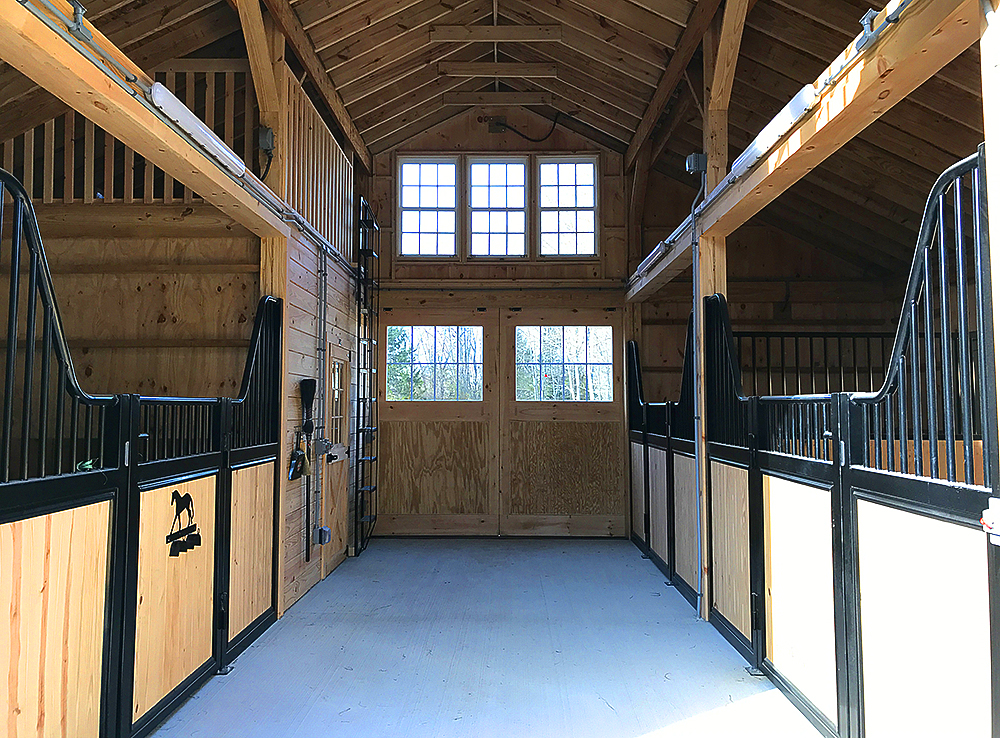
There are more interesting articles in our section on Tack & Farm.
Are you interested in promoting your business or sharing content on EIE? Contact us at info@equineinfoexchange.com
Horizon Structures Presents: The Top Five Most Important Features to Feature in Your New Horse Barn

By Nikki Alvin-Smith
When considering various features of a barn, (regardless of whether you are going prefabricated, pole barn or stick built), it is important to carefully question the builders under consideration for the project as to which features are included in the price and which features you will be charged extra fees to include.
1. The Outside Spectacle
When choosing your new barn design it is wise to first consider how it will impact your property visually. What type of roofing and siding do you want and what colors? With the choice of color and product you should also think about maintenance and snowfall. For example, a metal roof will shed snowload better than shingle, but will also be noisier inside the building unless you add insulation underneath the roof.
2. Light is Right
Everyone loves a light barn. Regardless of whether you choose a sash window, transom window or other design it is important that the interior of the window have a protective grill. Think about how you will clean the windows too. This is at a minimum a bi-annual chore, so ease of operation and reach is important. Also consider prevailing winds and airflow in your building and try to maximize airflow. Windows add valuable light and can minimize the use of electric. You can also add skylights for natural light.
Shutters are a pretty addition but make sure they are out of the reach of inquiring equine mouths. These can be decorative or functional.
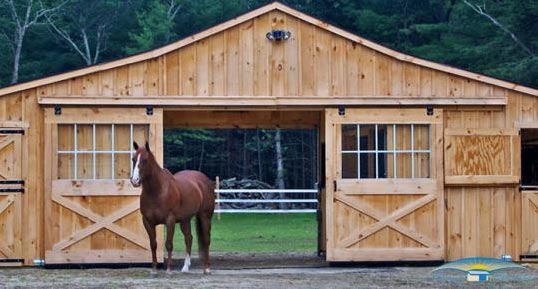
3. Fresh Air Everywhere
Windows will add fresh air when open but you might also like to add a cupola, which can increase air circulation in your barn. Electric fans can be added to the interior of the cupolas to increase air movement and a beautiful weathervane on top completes a pretty picture. Also consider gable and ridge vents and even hinged vents if you live in a warm climate. Note that vents should be covered with wire to prevent birds entering the building and setting up residence.
If you use grills between stalls and on the front of stalls these will also increase both light and airflow.
4. Kickboards & Partitions
Partitions and Doors:
Every horse stall should be kickboarded for the safety of the horse and for preservation of the building. Heavy-duty metal chewguards are a great addition to protect all exposed wood surfaces. Most horses will chew wood to some degree if they are bored. A chewguard on a Dutch door is definitely money well spent.
How will you partition the stalls? Will you implement full walls of wood or a half wall with a grill above? Check the quality and finish of the metal grill and be certain that the bars are set a maximum of three inches apart to prevent accidents. If you have a breeding operation you may want removable partitions.
Doors may be grilled, solid or Dutch door styles. Sliding doors are the most popular for interior spaces as they will not block the aisle and are the safest option for daily use. Make sure the doorway width is a minimum of four feet wide. Remember one bad hit on the hip can damage a horse for life.
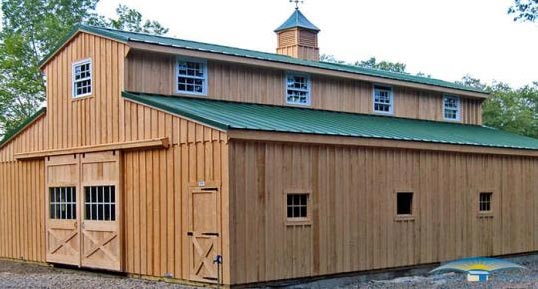
5. Storage of Tack and Supplies
We all know that we have a lot of horse ‘stuff’ to store: Saddles, bridles, blankets etc. plus the supplies our horse’s need such as grain, hay, shavings or straw. Think about whether you want loft storage for hay or a ground level storage area. Also decide whether that storage place will have a wood floor or if it will be bare dirt or concrete.
In conclusion when you are making the important decision to add a barn to the property you want to ensure you are making the best choice for you, your horses and your lifestyle. Professional experience counts and great companies provide experience, sincerely good advice and a great product. Do your due diligence and ask lots of questions and be certain that you are truly comparing apples to apples when making your final choice.
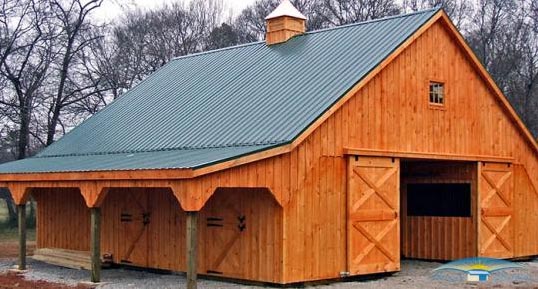
This article is brought to you courtesy of Horizon Structures Inc., Atglen PA – Modular horse barn and indoor riding arena specialists. Please visit www.HorizonStructures.com to learn more.
About Horizon Structures LLC: One horse or twenty, there's one thing all horse owners have in common...the need to provide safe and secure shelter for their equine partners. At Horizon Structures, we combine expert craftsmanship, top-of-the-line materials and smart "horse-friendly" design to create a full line of sheds and barns that any horse owner can feel confident is the right choice for their horses' stabling needs.
All wood. Amish Made. Most of our buildings are shipped 100% pre-built and ready for same-day use. Larger barns are a modular construction and can be ready for your horses in less than a week. All our barn packages include everything you need -
Horizon Structures also sells indoor riding arenas, chicken coops, dog kennels, 1 and 2 car garages, storage sheds and outdoor living structures.
Headquartered in South-Central Pennsylvania, Horizon Structures, LLC is owned by Dave Zook. Dave was raised in the Amish tradition and grew up working in the family-owned shed business. He started Horizon Structures in 2001 in response to an ever-increasing customer demand for high quality, affordable horse barns.
For additional information about the company or their product line, please visit their website at www.horizonstructures.com.
About Nikki Alvin-Smith: International and national published freelance writer and photographer in such world renowned publications such as The Chronicle of the Horse, Horse and Hound, Dressage and CT, The Horseman’s Yankee Pedlar, The Equine Journal, Spur, Hoofprint, Horsin’ Around, Horses All, Field & Stream, Horse Bits, Pony Quarterly, Catskill Horse to name a few.
Ghostwriting, blog services, PR/Marketing copy either direct with manufacturer or for agencies, copy editing and editor services also available. Nikki has produced catalog copy, corporate brochures and advertising copy for international corporations and PR/Marketing for celebrities.
As a Brit who has called the America home for the past 34 years, Nikki brings a unique perspective to the equestrian world. Nikki is also an accomplished Grand Prix dressage trainer/competitor, competing at international Grand Prix level to scores over 72% and is a highly sought clinician offering clinics worldwide.
She has been a horse breeder/importer of warmblood and Baroque breeds for more than 25 years. Together with her husband Paul who is also a Grand Prix trainer, they run a private dressage breeding operation and training yard in the beautiful Catskill Mountains of New York. Please visit www.NikkiAlvinSmithStudio.com to learn more.
There are more interesting articles in our section on Tack & Farm.
Are you interested in promoting your business or sharing content on EIE? Contact us at info@equineinfoexchange.com
Horizon Structures Presents….Don’t Fool Around with Foal Safety
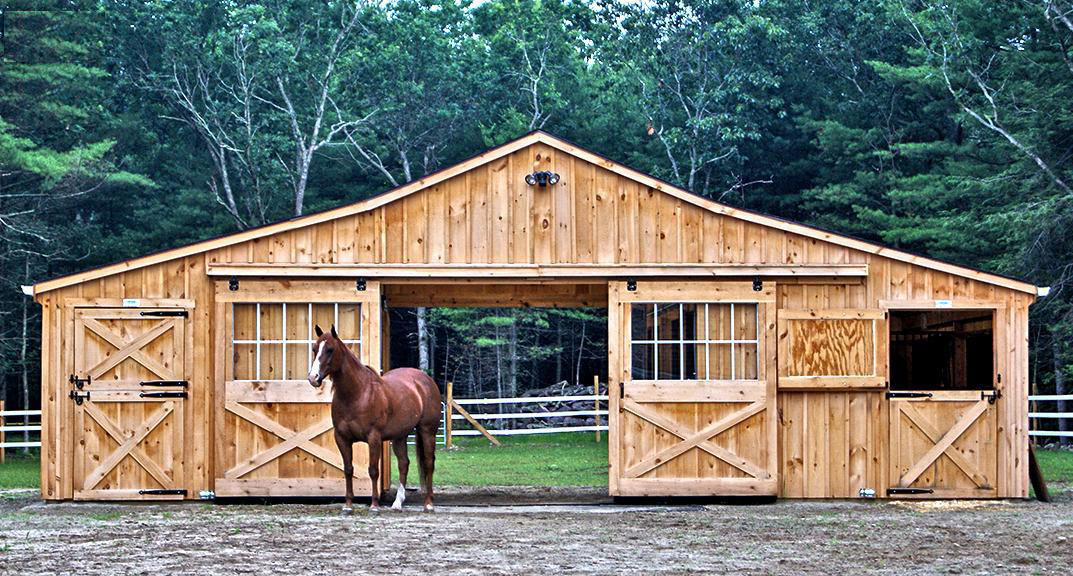
By Nikki Alvin-Smith
The foal is the goal and the goal is to keep that foal happy and healthy. Every year foals die due to accidents. While some no-one could have foreseen, some are preventable. Many occur due to poor stall design.
The comfort and safety of ‘Mom’ is paramount. Your mare needs to have space to move around before, during and after birth. The ideal size stall would be 12 x 24 feet for a 16 h.h. horse. To achieve this stall size you may not wish to have a designated stall all year round, so when you design your new barn if you have any thoughts at all that you may have a pregnant mare in your future herd, either by design or accident, it is wise to factor in stall conversion.
If you implement a dividing stall wall that may be removed for foaling season, it will save you much heartache and provide your mare with the space she needs. The boards and/or grills may be removed from the channels and the channels removed to complete this new maternity ward. No sharp edges allowed.
When your mare goes into labor, she may throw herself about the stall as if experiencing a colic. The walls of a stall should therefore be solid board rather than the thinner tongue and groove pine. You can use 2x8 or 2x6 boards.
The larger the board you use the stronger. The walls should also have support in the middle through either a wall straightener or brackets and be certain that no nails protrude.
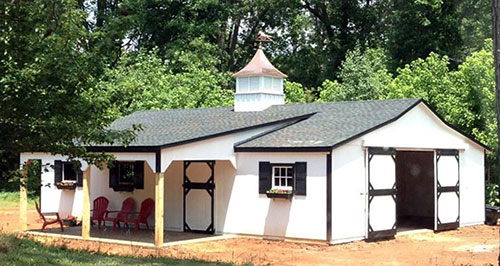
The walls should not reach to the ceiling of the building as this impedes air-flow, but all walls including the front wall should be high enough that the foal cannot rear and catch a leg on top.
The walls should be treated for easy cleaning. Before the big ‘birthday’ rolls around you may need to clean down the walls with a power washer or by hand with a brush and use an approved hospital grade non toxic disinfectant to kill both gram negative and gram positive bacteria.
Foals are apt to rear, jump and generally bounce about so it is important that any grills that remain in the stall, the front wall for example, have bars a maximum of three inches apart so that hooves do not become trapped during errant behavior. It is also important to remove extra bucket hangers, mangers or other ‘traps’ that the foal could encounter in his exuberance.
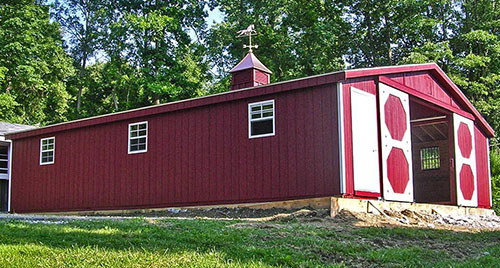
Light and ventilation are also important. A well-lit stall will carry less bacteria and make a happier environment for the mare. You do not want any draughts, and while grill doors that extend all the way to the floor may be useful in hot climates, large gaps beneath doors or walls are an accident waiting to happen.
Good ventilation will help prevent respiratory issues. If you have a stable door that opens to the outside of the building, be certain it is high enough and has an outdoor safe grill closure or Dutch door design so it can be closed in bad weather or closed for the duration to protect the foal catching a hoof on the top or trying to leap outside.
Many horses suffer stifle injuries that can be permanent soundness issues as a result of these activities.
The ground should be rubber matted or covered with some form of non-slip flooring suitable for horses (especially if you have concrete floors beneath), to prevent injury and keep the foal warm.
And as you surely know, mares should be bedded on either wheat or oat straw (not barley due to the husk barbs that can cause choke) as the ‘Birthday’ draws close, as shavings harbor harmful bacteria that can invade the foal’s immune system through the navel.
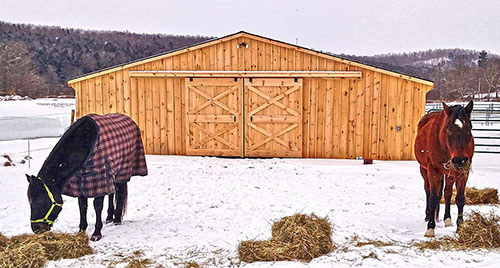
When planning a new barn build always think of resale, and of future needs. If you need advice seek out a professional company that has experience with barn building for equines. Horses are not cows.
Happy Horse Breeding!
This article is brought to you courtesy of Horizon Structures Inc., Atglen PA – Modular horse barn and indoor riding arena specialists. Please visit www.HorizonStructures.com to learn more.
About Horizon Structures
One horse or twenty, there's one thing all horse owners have in common...the need to provide safe and secure shelter for their equine partners. At Horizon Structures, we combine expert craftsmanship, top-of-the-line materials and smart "horse-friendly" design to create a full line of sheds and barns that any horse owner can feel confident is the right choice for their horses' stabling needs.
All wood. Amish Made. Most of our buildings are shipped 100% pre-built and ready for same-day use. Larger barns are a modular construction and can be ready for your horses in less than a week. All our barn packages include everything you need.
Horizon Structures also sells indoor riding arenas, chicken coops, dog kennels, 1 and 2 car garages, storage sheds and outdoor living structures.
Headquartered in South-Central Pennsylvania, Horizon Structures, LLC is owned by Dave Zook. Dave was raised in the Amish tradition and grew up working in the family-owned shed business. He started Horizon Structures in 2001 in response to an ever-increasing customer demand for high quality, affordable horse barns.
For additional information about the company or their product line, please visit their website at https://www.horizonstructures.com
About Nikki Alvin-Smith: International and national published freelance writer and photographer in such world renowned publications such as The Chronicle of the Horse, Horse and Hound, Dressage and CT, The Horseman’s Yankee Pedlar, The Equine Journal, Spur, Hoofprint, Horsin’ Around, Horses All, Field & Stream, Horse Bits, Pony Quarterly, Catskill Horse to name a few.
Ghostwriting, blog services, PR/Marketing copy either direct with manufacturer or for agencies, copy editing and editor services also available. Nikki has produced catalog copy, corporate brochures and advertising copy for international corporations and PR/Marketing for celebrities.
As a Brit who has called the America home for the past 34 years, Nikki brings a unique perspective to the equestrian world. Nikki is also an accomplished Grand Prix dressage trainer/competitor, competing at international Grand Prix level to scores over 72% and is a highly sought clinician offering clinics worldwide.
She has been a horse breeder/importer of warmblood and Baroque breeds for more than 25 years. Together with her husband Paul who is also a Grand Prix trainer, they run a private dressage breeding operation and training yard in the beautiful Catskill Mountains of New York.
There are more interesting articles in our section on Tack & Farm.
Are you interested in promoting your business or sharing content on EIE? Contact us at info@equineinfoexchange.com






